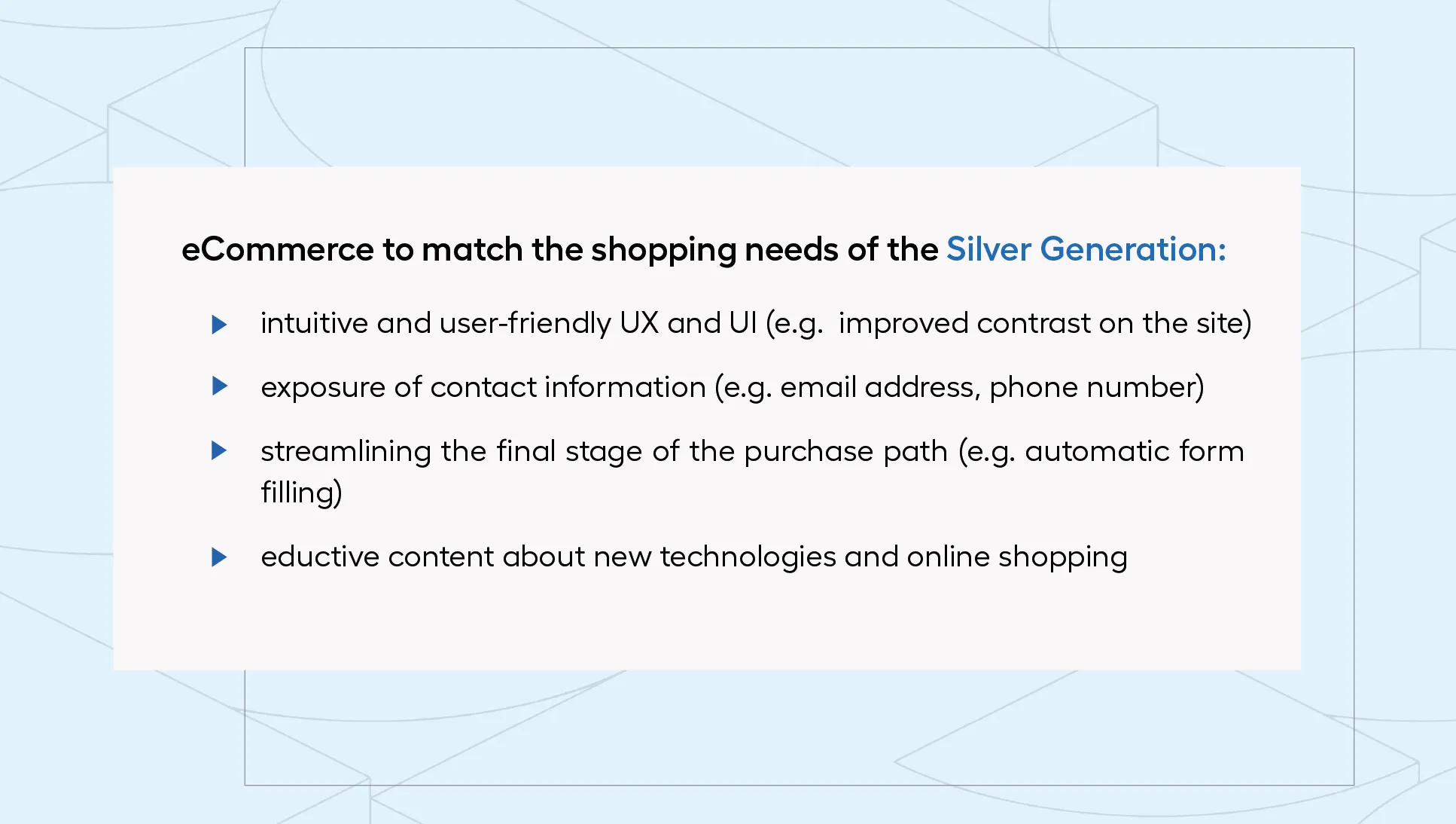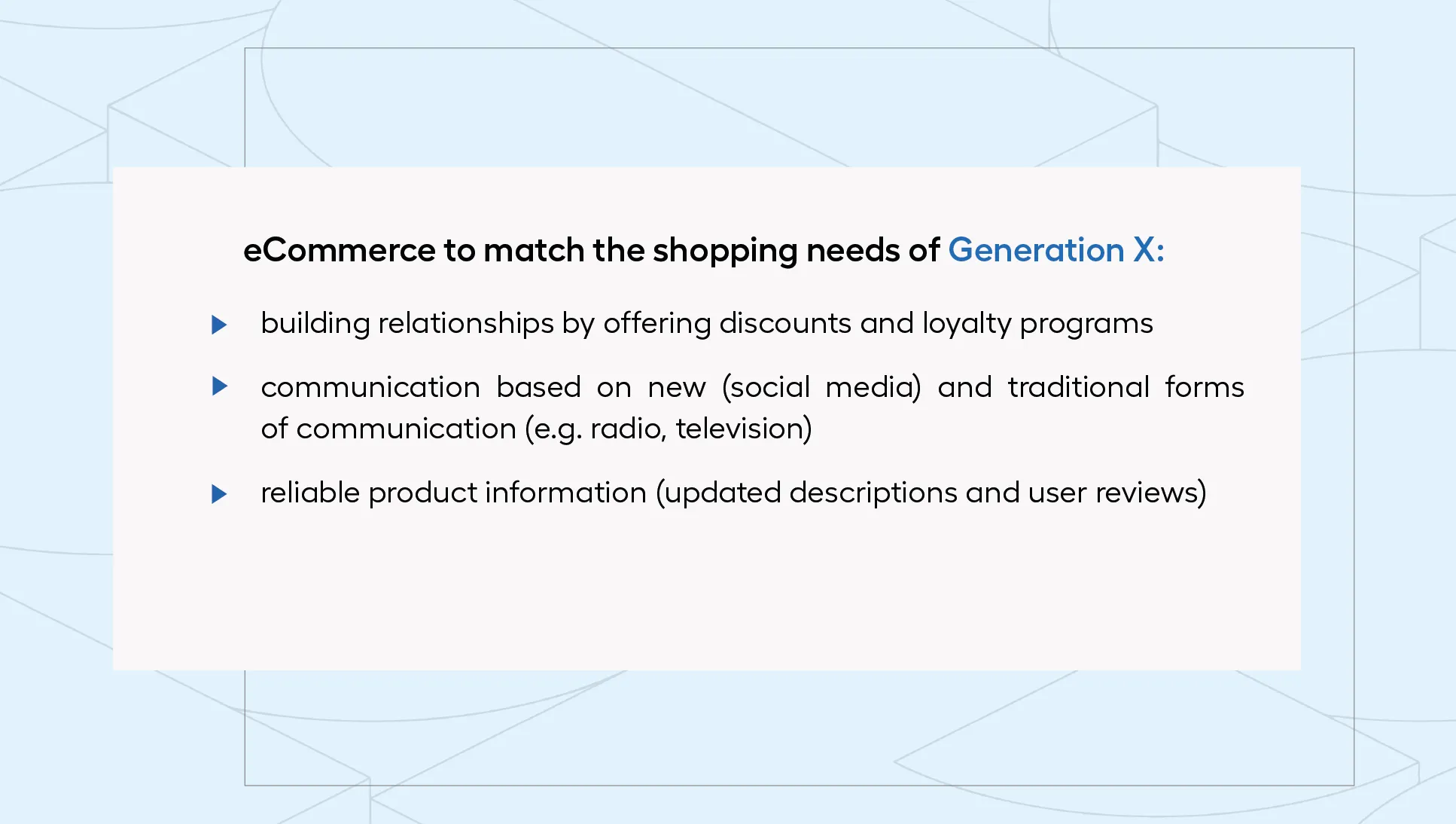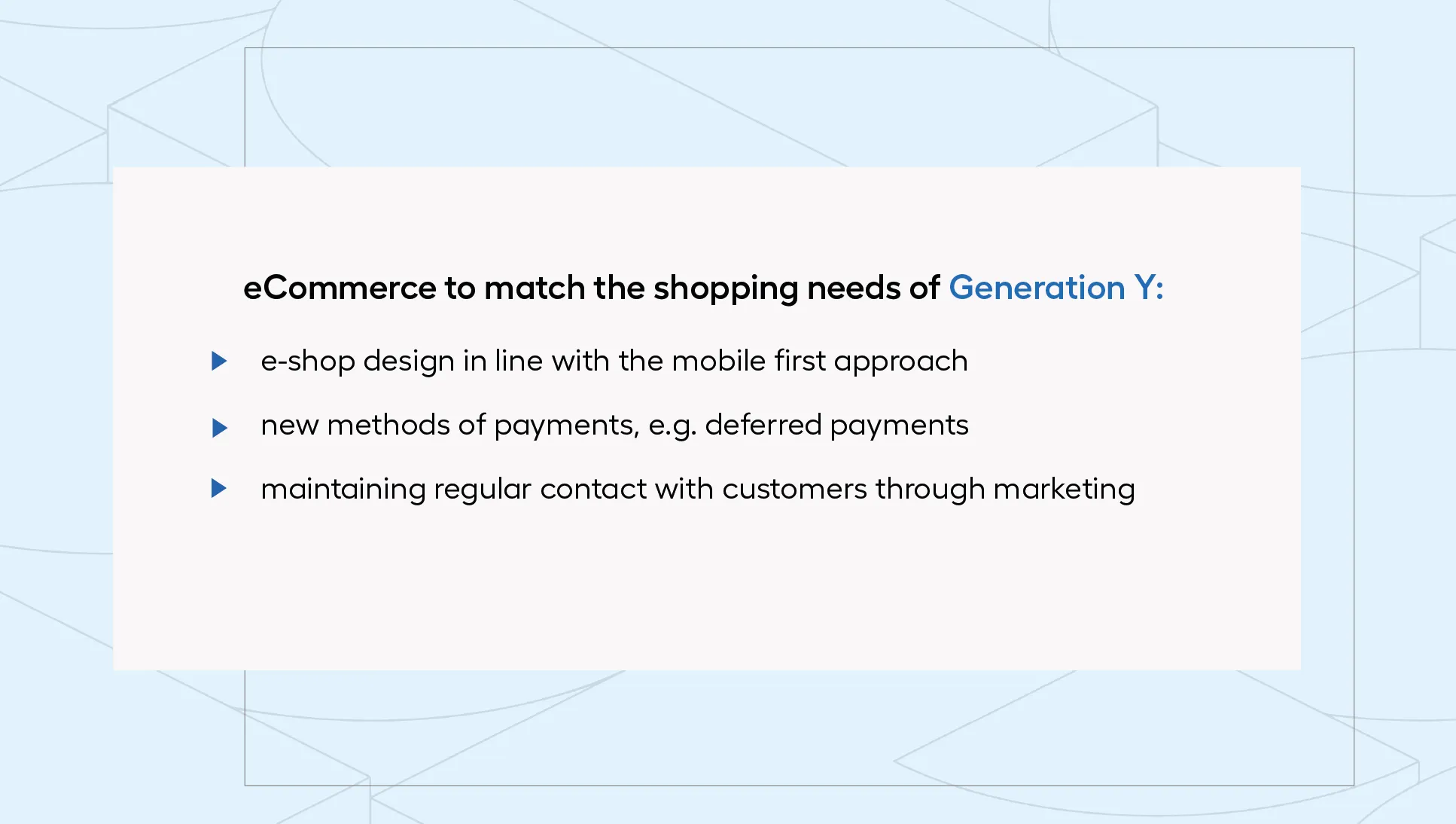More than 70 percent of representatives of the oldest generation say they actively use the Internet. Millenials and Gen Z are equally likely to choose to buy products from the lifestyle category online. Moreover, the statistical Pole, regardless of age, spends about 2 hours on social media. All this suggests that the boundaries between generations are now blurring - group belonging is increasingly reflected not only by the number written in the metric, but by experiences embedded around specific experiences (e.g. historical or social). Nevertheless, each generation is still distinguished by unique shopping habits, which are worth taking care of when running your online store.
X, Y or Z - who is the customer of your online store?
Have you ever wondered whether your online store is visited more often by Gen Z representatives, or whether Millenials spend the most time on your site? Platform tracking tools such as Google Analytics will help you determine which generation your shoppers mostly belong to. We, on the other hand, will show you what sort of operations and functionalities you should implement in your eCommerce to guarantee your buyers a shopping experience tailored to their characteristics. You may find that the expectations and needs of consumers (and, increasingly, contractors) who are only a few years apart differ dramatically. Read on and find out if your eCommerce "speaks" the language of your potential customers.
Silver generation - conscious eCommerce users
The beginning of the decade, particularly the pandemic experience, made eCommerce a place for everyone - the Silvers generation, i.e. people born before 1964, began to move online more often and more confidently. According to a survey conducted in 2022 by the Kobiety e-biznesu Foundation titled: "Pokolenie Silvers w eCommerce" as many as 86% of seniors said they use the Internet every day, with more than half of them being recipients of eCommerce services. The above results lead to a simple conclusion - online stores should tailor their offerings to a new (and for a long time overlooked) category of shoppers. How to convince the silver generation to shop online regularly?
The priority for 60+ consumers is convenience and security - their assurance is enhanced by paying attention to:
- UX and UI of the online store - a clear interface will be particularly important for this group of buyers. Above all, the site must be easy and intuitive to use. For this reason, it is worth taking care of, among other things, the ability to enlarge the font, improve contrast on the page, smart product search or clear photos of items.
- contact - a sense of security and building trust in the brand will also be largely influenced by the appropriate prominence of contact information (phone number or e-mail address of the company). In this way, the customer will have the feeling that he can always count on help.
- the final stage of the purchase path - at this point it is worth considering the introduction of auto-filling forms or expanding the catalog of deliveries and payments. Admittedly, seniors over the past 3 years have become more and more willing to use popular options (BLIK payments are already used by every 6th person over 60), but they still often choose less popular forms among other generations such as payment on delivery.
When targeting so-called "Silvers", it is worth bearing in mind that they are also distinguished by their need for education and willingness to learn about technology. In the report "Odpowiedzialny e-commerce 2021" by the Chamber of the Digital Economy, more than 50% of consumers indicated that online stores should teach how to buy safely online. Putting this type of information (e.g. in the form of a short video course or infographic) on the site or planning pro-education activities in the marketing strategy will add value and will certainly have a positive impact on building long-term relationships with the silver generation of shoppers.

Generation X - between tradition and new age in eCommerce
Those born between 1965 and 1980 can undoubtedly be called the generation of change. Generation X in Poland grew up in a time of political and economic transition. These are the people who were the last to grow up without widespread access to the Internet, and at the same time they were the first to experience the effects of dynamic speed-up in technology.
The X consumers are characterized by both openness to change and attachment to tradition. For this reason, "X" are a generation often overlooked in eCommerce marketing strategies, as they can quickly find their way in the middle of new developments. However, overlooking their needs can compromise their overall shopping experience. So what is worth paying attention to?
Today's 40- and 50-year-olds are open to new technologies and have no fear of testing innovative solutions, but they also trust traditional solutions. They are often best encouraged to buy by an attractive discount or the possibility of joining a loyalty program. To a large extent, they also still use traditional media such as press, radio and television - targeting this group with their offer will therefore continue to be important. Interestingly, statistical representatives of generation X are spending more and more time on social media (32 hours a week on average) and are most likely to use Facebook. 70% of them say they make purchases through the marketplace platform operating within this social network.
Generation X members are also characterized by a commitment to quality - they trust proven brands and pay attention to reliable product information. For this reason, it will be good practice not only to make comprehensive product descriptions and keep them updated (an external PIM system will help with that), but also to highlight reviews from other customers and industry experts on the site (more than 70% of X customers make decisions based on reviews). This way buyers will not have to search for information on other portals, and thus their attention will remain focused on the product. It's worth taking care of such details, if only because generation X people make up a significant part of the country's purchasing power.

Generation Y - does eCommerce belong to the Millenials?
It would seem that everything has probably been written about Millenials - without a doubt, those born between 1981 and 1996 are the most studied and commented on (who hasn't heard the joke about Millenials at least once?) age group. What accounts for their popularity?
Generation Y are those raised in a period of free market economy and globalization amidst rapidly emerging technological innovations. They place great importance on self-realization, the development of their own interests, and value the acquisition of experiences (e.g. through travel). It is for these reasons that they are the backbone of modern commerce, especially its electronic counterpart. The "PayPal eCommerce Index 2022" study shows that as many as 38% of Millenials shop online at least once a week. What issues do they pay particular attention to when browsing online stores?
M for mobile
It is mcommerce that Millenials most often rely on, with more than 60% of them reaching for mobile applications first. When targeting representatives of generation Y, it is worth bearing in mind that an online store's website should not only have a version tailored to mobile devices, but also provide experiences similar to those created by dedicated mobile applications. The answer to this need may turn out to be PWA technology, which extends the functionality of the traditional sales platform with such possibilities as sending push notifications or using location.
M for methods of payment
E-shopping sites should be easy to use, and the entire shopping process should be quick and intuitive - a standard for all generations. Generation Y also pays special attention to payment options. They are most eager to use the BLIK code to finalize transactions. They also value the ability to pay for an order via digital wallets (Apple Pay or Gooogle Pay) and are bold about novelties such as deferred payments (during 2022, as many as 62% of Poles used the Buy Now, Pay Later option).
M for marketing
Millenials are a generation that bases their purchasing decisions largely on values and emotions. When buying a product, they pay attention not only to its price and quality, but also to other elements, such as the brand's vision, its social responsibility or the possibility of acquiring additional knowledge. Generation Y is the most likely to read a company's blog, and carefully read other users' opinions about the product. On the other hand, they are ready to make spontaneous purchases according to their feelings. A perfect example of this is the growing popularity of Black Friday and the high effectiveness of campaigns focused on real-time marketing (advertising products in response to high-profile situations in the world). In short, in communicating with Y customers, it is important to clearly and honestly present product information combined with maintaining regular contact, for example, on social media or through an email newsletter.

Generation Z - the future of eCommerce through the eyes of the younger generation
It is not without reason that Generation Z (born between 1997 and 2012) also used to refer to themselves by the letter "C", behind which are the words: connect, communicate and change. They perfectly reflect the nature of this generation - Gen Z are people raised in a global world, for whom technology is a natural habitat. They spend time online both for pleasure and in search of information about the world. Online shopping is no longer just a choice for them, but increasingly the only obvious option. It is for this reason that they have the highest requirements for flawless operation of platforms or their loading speed. What other elements are worth paying attention to when targeting the younger generation?
Ideas first, (e)shopping second
A research project by the Snapchat app and Omnicom Media Group team found that as many as ¾ of Generation Z representatives remain more loyal to brands when they advocate change and social issues. The younger generation pays attention to whether companies are taking a stand on important issues, and they expect it to remain relevant to a changing world. They thoroughly check information on sustainability, work culture or eCommerce visions - if they don't find such content on the site or their expectations are simply not met, there is a high probability that they will decline to make a purchase.
Social media presence key to success
However, in order to successfully sell on social media, you need to prepare properly. Users of such portals are accustomed to consuming a large amount of dynamic content in a short period of time on various platforms (TikTok, Instagram, Twitter and, increasingly rarely, Facebook) - so the most important thing for the success of your brand will be to skillfully differentiate yourself from others, including competitors. It's worth betting on video content, following trends and communicating in natural language, and transferring these practices directly to your online store page.

The faster the better the shopping experience
Gen Z are also concerned about their time, both for the order finalization process and the delivery of the products themselves. To a large extent, this is why quick commerce shopping that guarantees delivery to the door within minutes (currently being developed not only in the grocery industry, but also in online fashion stores) has gained popularity. In the mind of young consumers, concepts such as parcel machine pickup and quick payment methods are the mainstay, and the competitive advantage of an e-store is only evidenced by its openness to the newest technologies. The use of VR or AR (e.g., to create virtual fitting rooms) or entry into metaverse reality can prove to be an important differentiator.
Lead your eCommerce in harmony with all generations
Generational differences continue to influence how we make decisions - being aware of the needs and understanding the lifestyles of representatives of each generation will help increase satisfaction. This makes it possible to build long-term ties based on shared values. While building a consistent communication, it is also worth taking care of the basic elements which you will be able to efficiently adapt to the needs of your audience. A good UX, a responsive storefront or a broad payment catalog are elements that will ensure your timeless success. And if you need inspiration, see how we've taken care of diverse customer needs in the projects we've completed.



